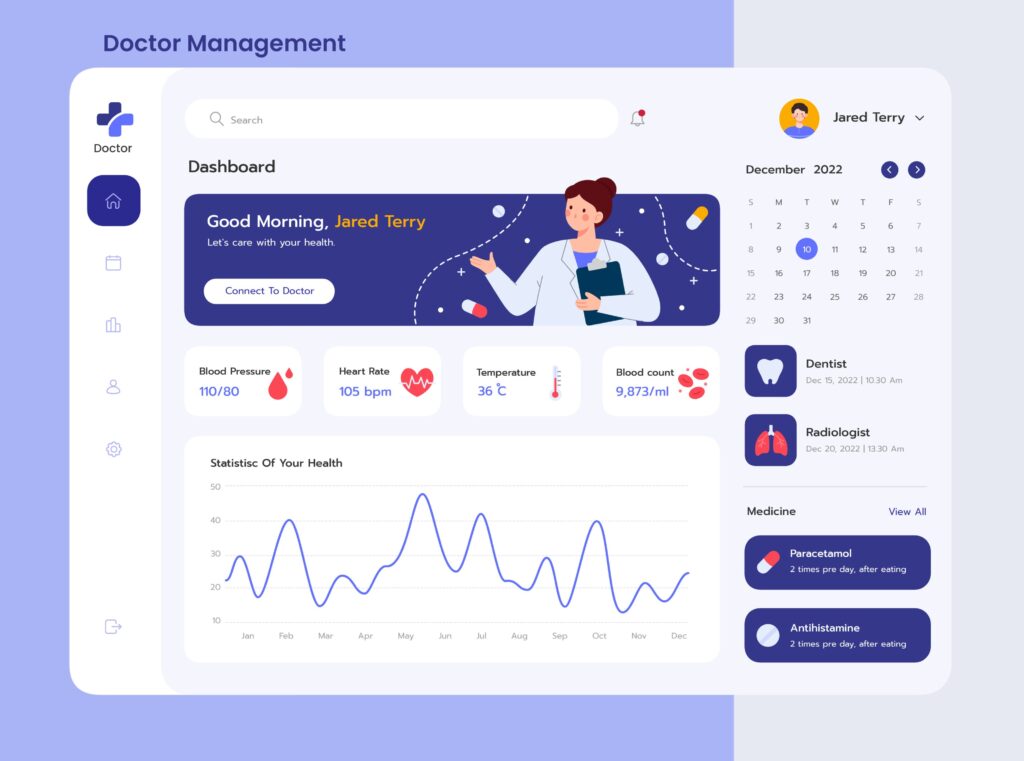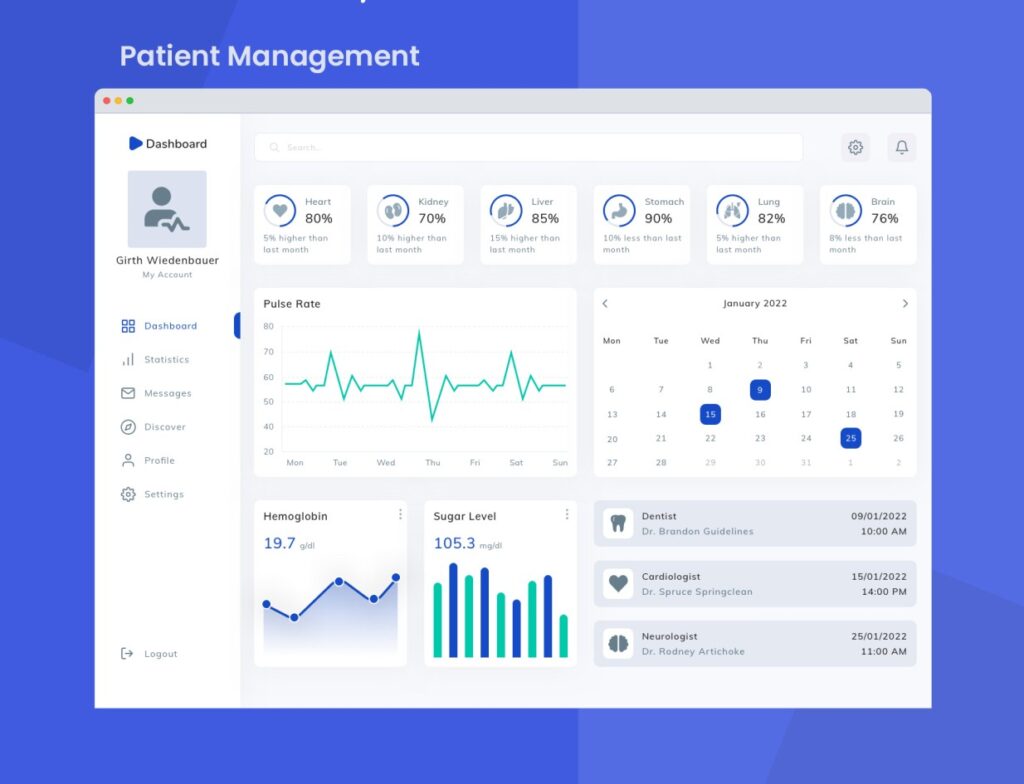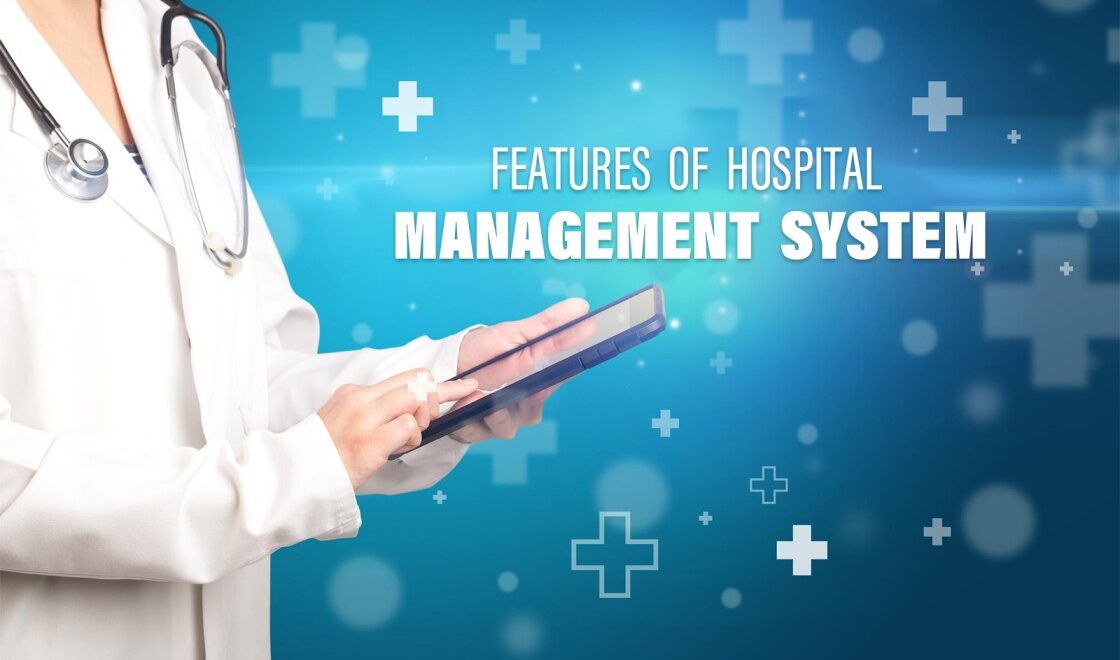Over the last few years, the demand for convenient healthcare services has surged significantly. This increase is largely driven by the rapid digitization of the healthcare industry, leading to the implementation of numerous software systems and tools in medical institutions. One of the most critical systems in healthcare is the Hospital Management Software (HMS) system. This software automates routine tasks such as billing, inventory management, and document management, thereby streamlining operations and reducing administrative burdens.
In this blog, explore how SaaS-based HMS can boost patient care. These systems offer a complete solution for modern healthcare, from cutting errors and speeding processes to enhancing data security and patient management, shaping the future of healthcare.
What is Healthcare Management Software?
Hospitals have paperwork and waste patient’s time by processing the paperwork. However, the healthcare management software(HMS) streamlines various administrative and clinical operations within medical institutions. This software reduces paper-based processes, significantly cutting down on paperwork and the potential for lost documents.
HMS effectively stores and manages patient data, ensuring information is easily accessible and securely maintained. By integrating various software tools, HMS offers functionalities such as billing, inventory management, appointment scheduling, and electronic medical records (EMR). Statistics show that the adoption of HMS can lead to a 15-30% increase in operational efficiency and a 20% reduction in administrative costs, thereby enhancing overall patient care and institutional performance.
Features of Hospital Management Software
Hospital management software is a comprehensive digital solution designed to streamline various administrative, clinical, and financial processes within a healthcare institution.
For Hospitals

Here are some key features in hospital management software for hospitals
1. Patient Registration and Management
Hospital staff are required to diligently record and manage critical patient information, including their name, contact information, insurance detail, and medical records and more. It allows for easy retrieval and management of patient records.
2. Appointment Scheduling
Appointment scheduling efficiently allocates the consultation slots for patients with healthcare providers or specific departments. This feature helps hospitals use their resources better, makes patients wait less, reduces administrative work and gives them a better experience by making it easy to book appointments.
3. Electronic Medical Records (EMR)
EHR provides patients personal digital records. The healthcare professionals store and access the patient health records, including medical history, diagnoses, treatments, prescriptions, lab results, and imaging reports etc.
4. Billing and Invoicing
Hospital management software is essential for monitoring patient admissions and discharges, as well as assisting the hospital’s financial management. By automating billing procedures, it generates invoices for various healthcare services like consultations, treatments, and medications, and it can even connect with insurance systems to handle claims. This ensures transparency in billing practices, helping the hospital maintain trust with its patients.
5. Inventory Management
This functionality monitors and oversees the levels of medical supplies, pharmaceuticals, and other items used in hospitals. It ensures that there are enough supplies on hand, minimizes waste, and assists in promptly replenishing stock. Additionally, it aids in providing healthcare efficiently at a reasonable cost.
6. Laboratory Management
This software helps to schedule and monitor the laboratory tests. This helps to track the specimens, record results and reports. It improves turnaround times and enhances the accuracy of lab operations.
7. Pharmacy Management
The pharmacy management feature of hospital software streamlines the entire process of prescribing and dispensing medications. By allowing doctors to create and store electronic prescriptions easily, it reduces the burden on clinicians and minimizes medication errors. This system also tracks patients’ medical histories, ensuring they receive accurate and personalized treatment. Overall, it enhances efficiency, improves patient safety, and ensures proper medication management.
8. Analytics and Reporting
It helps to manage information and generates statistics to monitor the clinic performance and trends. It includes essential reports with patient data, association data, and business statistics. This enables data-driven decisions for planning healthcare facilities and budget allocation.
For Doctors

Here are some key features in hospital management software for doctors
1. Electronic Medical Records (EMR)
The EMR (Electronic Medical Records) system provides doctors with easy access to and editing of comprehensive patient records. This includes prior medical history, test results, diagnoses, and treatment plans. By facilitating accurate and efficient management of patient information, the EMR system enhances the quality of care and leads to more productive outcomes in patient treatment.
2. Appointment Scheduling
The appointment scheduling feature automates the process of booking and managing patient appointments. It simplifies scheduling, reduces administrative tasks, and ensures optimal time management. Doctors can update their availability, while patients can easily schedule their appointments, minimizing wait times. By coordinating appointments efficiently, it enhances the overall patient experience and allows healthcare providers to allocate their time effectively, delivering high-quality care.
3. Prescription Management
Prescription management in hospital software automates the process of prescribing and dispensing medications. It allows doctors to create, store, and manage electronic prescriptions, significantly reducing the risk of medication errors. This feature ensures accurate and efficient medication management by tracking patient prescriptions, preventing drug interactions, and supporting medication adherence which assures patient safety.
4. Diagnostic Support
This feature provides doctors with integrated tools and access to lab results and imaging reports and offers accurate and timely diagnosis information at their fingertips. Health providers can quickly identify the health issues that help to provide effective treatment plans. ultimately improving patient outcomes and the efficiency of clinical workflows.
5. Clinical Documentation
This feature facilitates the efficient patient records and clinical notes of patients to create, store, and manage. It allows healthcare providers to accurately record patient encounters, treatment plans, and medical histories. This feature ensures that all relevant patient information is easily accessible and up-to-date, supporting better clinical decision-making and enhancing the continuity of care. Additionally, it helps maintain compliance with medical standards and regulations, improving overall healthcare quality and patient outcomes.
6. Communication Tools
This tool provides secure and efficient channels for doctors to collaborate with other healthcare professionals and communicate with patients. These tools facilitate real-time messaging, video conferencing, and sharing of patient information, that facilitate better coordination and ensuring timely updates. By improving communication, these tools contribute to better patient care, streamlined workflows, and increased efficiency within the healthcare team.
7. Decision Support Systems
Decision Support Systems (DSS) offer doctors with evidence-based clinical guidelines and tools to assist in making informed treatment decisions. These systems analyze patient data and present actionable insights, helping to diagnose conditions accurately, choose appropriate treatments, and predict patient outcomes. By offering real-time support, DSS enhances the quality of care, reduces the likelihood of errors, and improves overall patient management and safety.
8. Telemedicine Integration System
The telemedicine integration helps to conduct virtual consultations, allowing doctors to diagnose and treat patients remotely. This system enhances accessibility to medical care, especially for those in remote or underserved areas, and reduces the need for in-person visits. It includes features such as video conferencing, secure messaging, and electronic sharing of medical records, ensuring continuity of care and maintaining patient privacy and security.
For Patients

Some key features in hospital management software for patients
1. Patient Portal
A patient portal is a secure online platform where patients can access medical records, view test results, and review treatment plans. This data is securely stored for future visits, so you don’t need to fill out the forms again. It helps them to schedule appointments, request prescription refills, and communicate with healthcare providers, enhancing engagement and supporting better health management.
2. Appointment Scheduling
The appointment scheduling feature in HMS allows patients to easily book, reschedule, or cancel appointments online. It reduces waiting periods and enhances overall patient satisfaction. It automatically reminds patients of appointments, leading to better adherence to medical advice and timely access to healthcare services.
3. Telemedicine Services
Telemedicine services provide patients with the convenience of consulting with healthcare providers remotely, using technology such as video conferencing. Patients can get medical advice, treatment, and diagnosis without leaving their homes.It can reduce the burden on healthcare facilities by minimizing unnecessary in-person visits.
4. Billing and Payment
The feature in Healthcare Management Systems (HMS) assists in handling patients’ medical bills. Also, it involves handling invoices, keeping track of payment statuses, managing filed claims, and providing different payment choices. This level of transparency and convenience improves the patient experience and guarantees timely and accurate financial transactions. It contributes to smoother operations within healthcare facilities.
5. Educational Resources
This feature sends patients reminders for crucial health check-ups or medication doses, helping them stay informed and on schedule with their healthcare needs. Moreover, it furnishes you with medical information to enhance your understanding of basic health concepts.It helps the healthcare providers about your health status.
6. Mobile Health Monitoring and Access
This feature allows users to access healthcare information and monitor their health using mobile devices. It enables patients to conveniently track vital signs, medication adherence, other health metrics, etc. Furthermore, it helps you easily talk with doctors and encourages you to stay informed about their health-related status.
Conclusion
As a software development company, Authorselvi specializes in crafting healthcare software that is feature-rich, high-quality, and user-friendly. Our seasoned developers offer custom solutions aimed at improving user experience. By leveraging cutting-edge technologies and adhering to healthcare standards, we prioritize the security of patient data. For consultations on healthcare-related applications, feel free to reach out to us at info@authorselvi.com.
